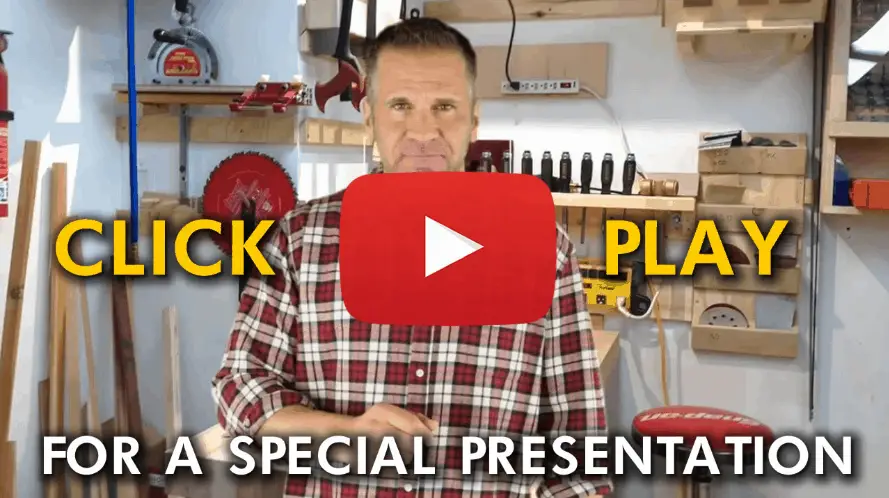Subscribe to Matthew Peech on YouTube
For newcomers to our channel, today’s video dives into the creative world of solving practical problems with DIY solutions.
The theme is all about transforming trending ideas from big box stores into unique, marketable products.
When choosing projects, they focus on the potential profitability and ease of construction, ensuring that anyone can undertake these builds with basic tools.
The featured project is a simple yet effective glasses organizer made from a piece of wood and a strip of leather.
This practical solution helps keep sunglasses and safety glasses organized, preventing them from being misplaced around the house.
Building it yourself allows for customization to match your personal style, whether it’s rustic or modern.
These kinds of DIY solutions not only solve everyday issues but also offer potential items for sale.
Key Takeaways
- The series explores profitable DIY projects inspired by big box store trends.
- Featured project: an easy-to-make glasses organizer using wood and leather.
- Customizable designs turn practical solutions into marketable products.
Series Overview
Popular Small Projects
This series teaches viewers how to create and sell small items that solve common problems.
Each episode explores what’s hot and trending in big box stores. He gives tips on putting a unique twist on these products, making them suitable for either personal use or selling.
When choosing items to feature, he looks for products that are easy to make, cost-effective, and can be produced quickly.
The main goal is to find projects with high profit margins. Almost all the builds require basic tools, making them accessible to everyone.
Creative Solutions
One example shared is a simple board with a strip of leather used to organize safety glasses and sunglasses.
Around the house, glasses can often end up scattered. This project uses scrap wood and leather, creating a practical and stylish solution.
There are many ways to adapt the design.
For instance, different materials like Walnut, cherry, or pallet wood could be used for various looks, from modern to rustic.
He used spent shell casings to attach the leather to the board, but other methods can work as well, such as weaving the material through slats in the wood.
Research Guidelines
Sales Potential
The main consideration is whether the product will appeal to buyers. Items that address a common need or problem tend to sell well.
Checking what’s currently popular in larger stores can also provide a good indicator.
Production Expenses
How much it costs to make the product is key. This includes materials, tools, and any other resources needed.
Finding affordable supplies, like getting scrap leather from Amazon, helps keep costs down and boosts profits.
Manufacturing Time
How quickly the product can be built is another factor.
Projects should be easy enough to complete in a short amount of time. Simple designs that can be made with basic tools are ideal.
Profit Margin
After considering the costs and time, it’s important to evaluate how much profit remains.
Items with high sales potential and low production costs are the most profitable. This balance ensures a good income for makers.
[Guide] How To Launch Your Woodworking Business For Under $1000
Click Here To View
If you’re considering turning your woodworking hobby into a part-time business check out this helpful guide on how to get started.
DIY Glass Organizer Project
Introduction to the Organizer
This project is all about creating a handy DIY organizer for holding safety glasses and sunglasses.
The idea is simple but effective, using a board and a strip of leather to keep glasses neatly stored and out of the way.
This organizer can help to keep homes tidy by providing a specific place for these frequently used items.
Understanding the Problem
Many people leave their sunglasses and safety glasses lying around the house, which can be messy and make them hard to find.
This project offers a solution to this problem by giving glasses a dedicated spot. The organizer is especially useful for households where multiple people need to store their glasses.
Design Explanation
The basic design consists of a rustic board with a strip of leather attached to it.
The leather is held in place with spent shell casings, and the glasses are held by sliding them into loops formed by the leather.
This setup can be customized in numerous ways to fit different styles and needs.
Customization Options
- Materials: Use different types of wood like walnut, cherry, or pallet wood for a unique look.
- Leather: Choose different types of leather or even fabric strips.
- Attachments: Instead of shell casings, use nails, screws, or other decorative items.
- Size: Adjust the length and width to fit the available space.
Construction Tips
- Measure and mark where you want the leather loops to go.
- Use CA glue or similar adhesive to secure the leather.
- Leave some slack in the leather to create loops that can hold the glasses.
- Space the loops evenly for a neat appearance.
Material Suggestions
- Wood: Rustic boards or pallet wood for a farmhouse look; walnut or cherry for a modern style.
- Leather: Scrap leather from Amazon or local craft stores.
- Attachments: Spent shell casings, screws, or nails.
- Adhesive: CA glue for strong, quick bonding.
[Video] 3 Most Common Mistakes
When Setting Up Shop

A woodworking friend of mine shared this video by Ralph Chapman with me that helped him set up his workshop.
The video explains the benefits of Ralph Chapman’s guide about setting up an affordable workshop and avoiding the most common mistakes offers to anyone interested in woodworking.
Considerations for Building
Leather Strip Usage
Leather serves as a great material due to its durability and aesthetic appeal. Additionally, it provides a rustic look that can complement various styles.
Scrap leather can be sourced online at affordable prices, making it a cost-effective choice for projects like organizing glasses.
Whether opting for natural or treated leather, its flexibility ensures easy customization to fit different designs and spaces.
Incorporating Spent Shell Casings
Spent shell casings can be creatively repurposed as fasteners in various builds.
These casings can hold leather strips in place when attached to a wooden board.
By spacing them about 1.5 inches apart, one can create loops for hanging items.
Securing the casings with adhesive ensures they remain fixed, providing both functionality and a unique design element.
Alternative Attachment Techniques
There are multiple ways to attach materials to your project.
Instead of shell casings, consider weaving leather strips through pre-cut slats in the wood.
The slats can be spaced about 1.5 inches apart to create a sturdy weave.
Other options include using metal brackets, screws, or decorative nails, depending on the desired look and material preference.
Size Recommendations
Dimensionally, the project is flexible to accommodate various spaces.
The recommended length range is between 18 to 24 inches. This size is practical for most settings while still allowing for customization.
The depth and width should also be considered based on the intended use and available space, ensuring the final piece is both functional and visually pleasing.
Marketing and Sales
Potential for Selling
Creating and selling items that solve everyday problems can be highly profitable.
For example, an organization system for glasses was devised using a simple board and a strip of leather. The ease of making such items makes them appealing to a wide range of people.
When researching what to sell, several factors are considered:
- Will the item sell?
- How much will it cost to make?
- How quickly can it be produced?
High-profit margins are a key criterion.
The potential for selling these items seems promising given the simplicity of creation and ability to customize.
Using basic tools and materials like scrap wood and leather, unique designs can be created to suit different tastes.
Such projects cater to common household needs, making them practical and marketable.
By modifying materials and designs, sellers can target various styles and preferences, whether rustic, modern, or farmhouse. Thus, the potential for success in marketing and selling these items is high.
DIY Side Table Idea
Interest in Small Tables
Small tables are popular in many homes. People use them in living rooms, bedrooms, and even hallways. They provide extra space for things like lamps, books, or drinks.
Since many big stores sell them, it shows that there’s a market for these items. This makes them a good choice for a DIY project that people can sell or use in their own homes.
Flexible Designs
One of the best things about making a DIY side table is the design freedom.
The table can be made to fit any style or room. Just by changing the paint color or type of wood, you can get a totally different look.
For example, walnut wood can give a modern feel, while pallet wood can give a farmhouse style. There are many ways to make each table unique and special.
Custom Tables
These tables are known by different names in stores. They might be called side tables, console tables, or accent tables.
No matter the name, they all serve similar purposes. They can add style and function to any room.
DIYers can create these tables with basic materials like 2x4s and 1x6s. This project is straightforward enough to use simple hand tools for building.
Want To Improve Your Woodworking?
Discover 1,000 Hours Of Step-By-Step Woodworking Videos

It’s called Woodwork101. A database of detailed videos and blueprints in crystal clear, mouth-watering HD that will take you by the hand and show you that DIY home projects done the right way are easy, fun, and always of top quality… turning dream into reality in a heart-beat. Getting you that perfect build each and every time.
Side Table Build Breakdown
Suggested Materials and Tools
To build a side table, the main materials are 2x4s for the legs and 1x6s for the sides and top. Here’s a list to help you gather everything:
Materials:
- 2×4 lumber: For the table legs
- 1×6 lumber: For the aprons and tabletop
- Wood screws or nails: To join pieces together
- Wood glue: For extra sturdiness
- Paint or stain: To finish the table
Tools:
- Hand saw or circular saw: To cut the lumber
- Hammer or drill: For assembling the pieces
- Tape measure: For accurate measurements
- Sanding block or electric sander: To smooth the wood
- Paintbrush or rag: For applying finish
Encouragement for Beginners
Building this side table is a great project for beginners. You can use basic tools and still end up with a beautiful piece.
If you don’t have all the materials on hand, you can buy them cheaply and the profit margin remains high.
Adjustments in paint, materials, and size can make it unique to fit any home style, be it modern or rustic.
Remember, the key is in the simplicity of the design, which makes it easy to start and complete.
Don’t let lack of experience stop you—jump in and enjoy the process!


